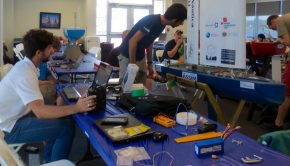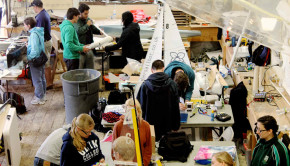SailBot: Next Generation Design and Competition
Published on June 29th, 2017
A rising crop of America’s Cup and maritime designers, engineers, naval architects, and controls specialists from eleven high school, university, and academy teams recently gathered for the 11th SailBot International Sailing Regatta in Annapolis, MD.
The Notice of Race and Class Rules for the International Robotics Sailing Regatta call for students to create an unmanned sailboat that navigates through a variety of challenges with limited, if any, human control.
The competition featured five contests: a remote-controlled fleet race; a station-keeping event in which boats stay in the same place for five minutes; a precision navigation race; challenge competitions covering payload/load bearing, collision avoidance, and search; a long-distance race; and team presentations.
Building a watertight boat and one that will sail on all points of sail is no small feat. Equally challenging is developing the navigation and control software and accommodating for variable wind and sea conditions.
Building a MaxiMOOP (Minature Ocean Observation Platform), which was used by several teams, or an original design, is a significant achievement. First year teams often arrive at the event with as much as another school year’s worth of work remaining before they can be competitive in all aspects of the event. Yet, there is a lot to be gained by participating.
Worcester Polytechnic Institute (Worcester, MA) won this year’s competition. They rebounded from their last place finish last year by shifting from a standard 1-meter hobby sailboat hull to a 2-meter hull. WPI’s five-member team spent triple the amount of time they had anticipated in developing a usable hull.
The most experienced sailors on the WPI team had no more than an introductory sailing PE course under their belts. According to Ken Stafford, Director of WPI’s Robotics Resource Center, “they attacked the problems as roboticists/engineers… As robotic engineers they knew how to use computer vision and autonomy, hence the relative success in the obstacle avoidance, station-keeping, and endurance event.”
Three SailBot teams, including WPI, arrived with solid wing sails. Ultimately, WPI resorted to using its soft sail for the competition, because it could not resolve electronic issues with its wing. Federal University of Rio de Janeiro’s three-man team had no prior sailing experience yet didn’t waste time building a traditional soft sail for their boat Gloria. Inspired by America’s Cup developments, they powered their SailBot with a two-element wing covered with sponsor logos.
Students learned a tremendous amount throughout the five-day event, which included seminars. WPI’s team that struggled to sail well on all points of sail “continued to develop the navigation and control software via their simulator while others on the team struggled to get the boat sailable.” According to Stafford, “eventually, the team did not totally resolve the sailability issues until the last few days of this competition!”
No doubt, sailing will continue to be the source of tremendous breakthroughs, especially for all of the young people around the world who have the opportunity to experience its hands-on learning opportunities and camaraderie during international competitions.
Source: Lynn Fitzpatrick








 We’ll keep your information safe.
We’ll keep your information safe.